(Doc) Financial Reporting Sample Assignment
VerifiedAdded on 2021/02/20
|14
|4016
|63
AI Summary
Contribute Materials
Your contribution can guide someone’s learning journey. Share your
documents today.
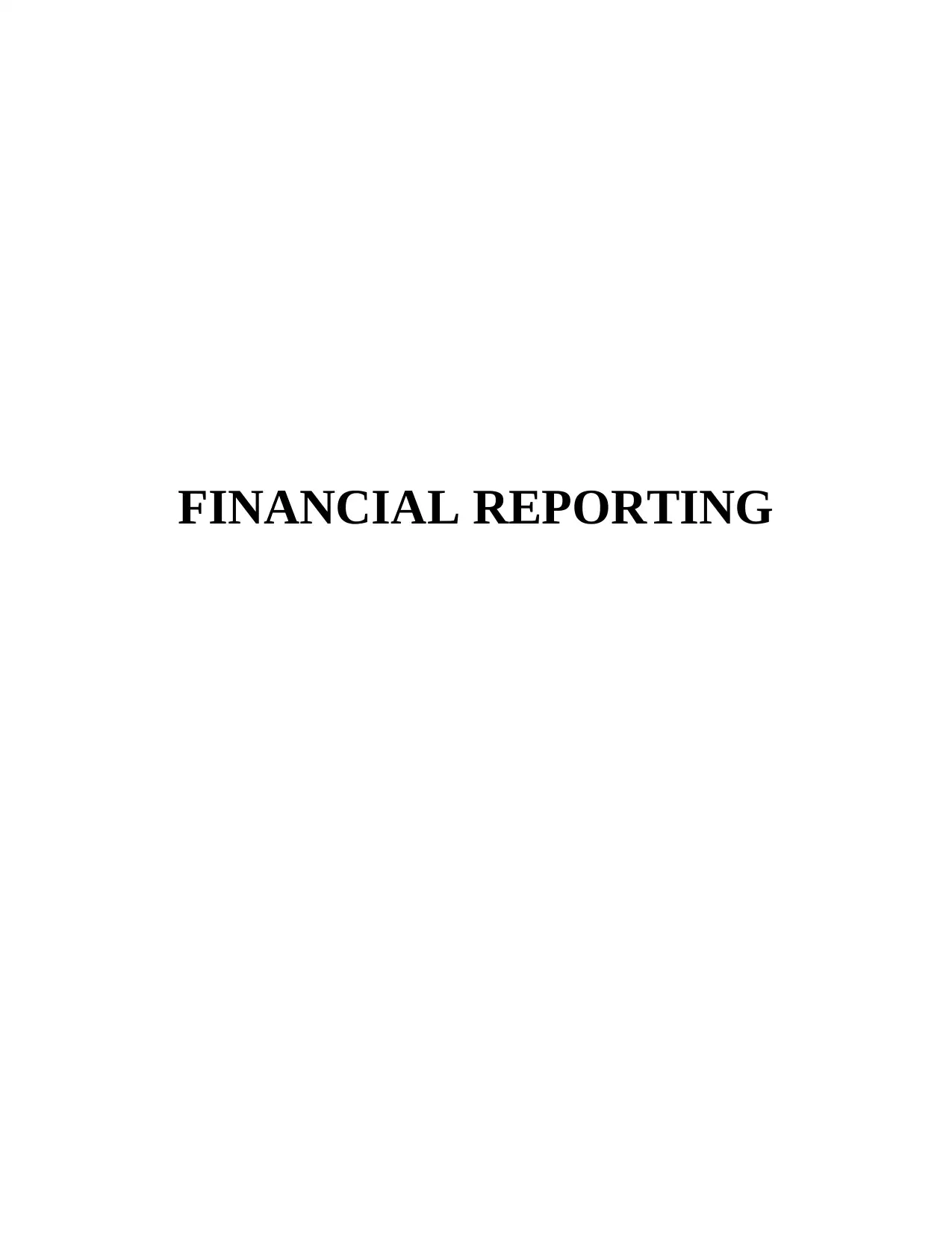
FINANCIAL REPORTING
Secure Best Marks with AI Grader
Need help grading? Try our AI Grader for instant feedback on your assignments.
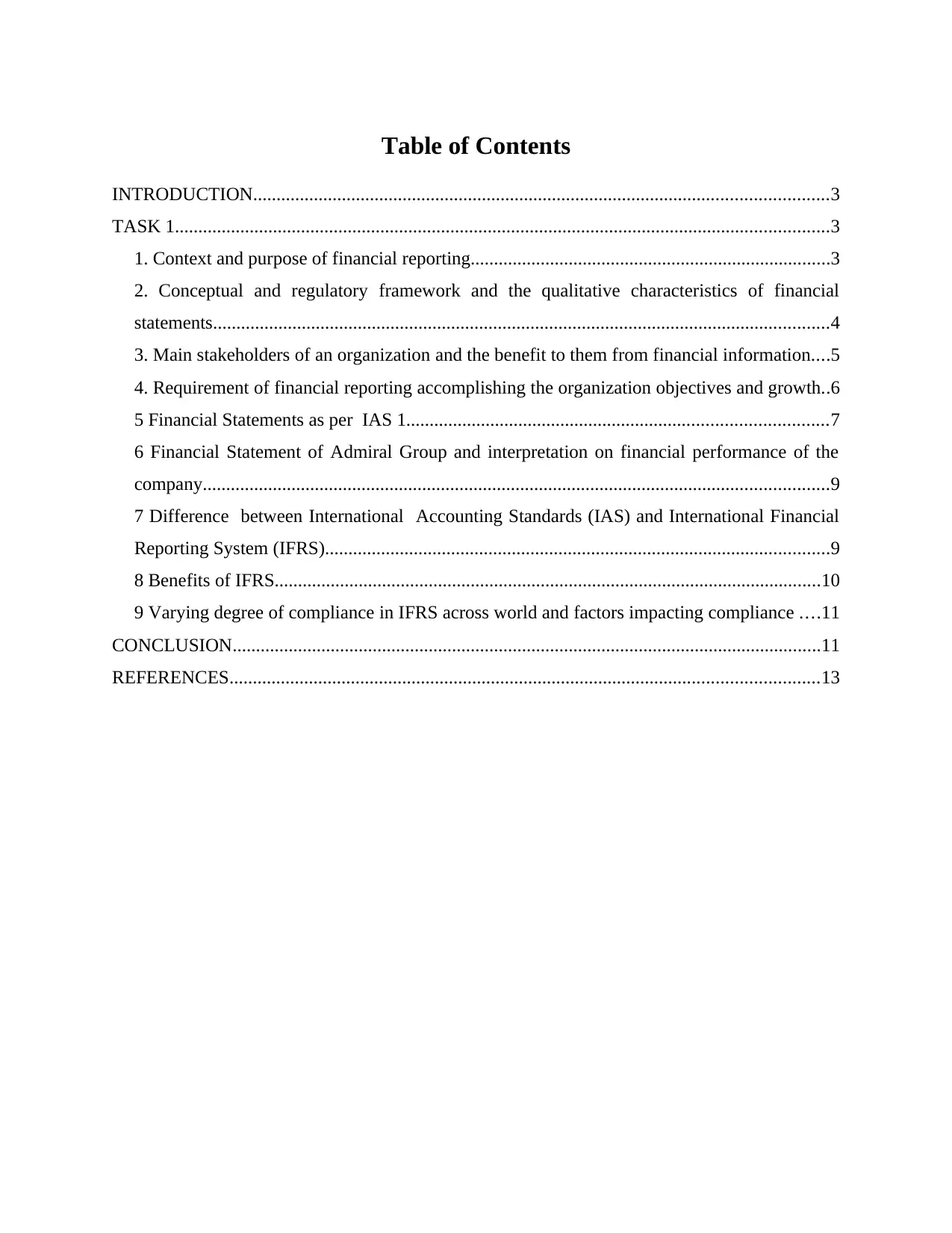
Table of Contents
INTRODUCTION...........................................................................................................................3
TASK 1............................................................................................................................................3
1. Context and purpose of financial reporting.............................................................................3
2. Conceptual and regulatory framework and the qualitative characteristics of financial
statements....................................................................................................................................4
3. Main stakeholders of an organization and the benefit to them from financial information....5
4. Requirement of financial reporting accomplishing the organization objectives and growth..6
5 Financial Statements as per IAS 1..........................................................................................7
6 Financial Statement of Admiral Group and interpretation on financial performance of the
company......................................................................................................................................9
7 Difference between International Accounting Standards (IAS) and International Financial
Reporting System (IFRS)............................................................................................................9
8 Benefits of IFRS.....................................................................................................................10
9 Varying degree of compliance in IFRS across world and factors impacting compliance ....11
CONCLUSION..............................................................................................................................11
REFERENCES..............................................................................................................................13
INTRODUCTION...........................................................................................................................3
TASK 1............................................................................................................................................3
1. Context and purpose of financial reporting.............................................................................3
2. Conceptual and regulatory framework and the qualitative characteristics of financial
statements....................................................................................................................................4
3. Main stakeholders of an organization and the benefit to them from financial information....5
4. Requirement of financial reporting accomplishing the organization objectives and growth..6
5 Financial Statements as per IAS 1..........................................................................................7
6 Financial Statement of Admiral Group and interpretation on financial performance of the
company......................................................................................................................................9
7 Difference between International Accounting Standards (IAS) and International Financial
Reporting System (IFRS)............................................................................................................9
8 Benefits of IFRS.....................................................................................................................10
9 Varying degree of compliance in IFRS across world and factors impacting compliance ....11
CONCLUSION..............................................................................................................................11
REFERENCES..............................................................................................................................13
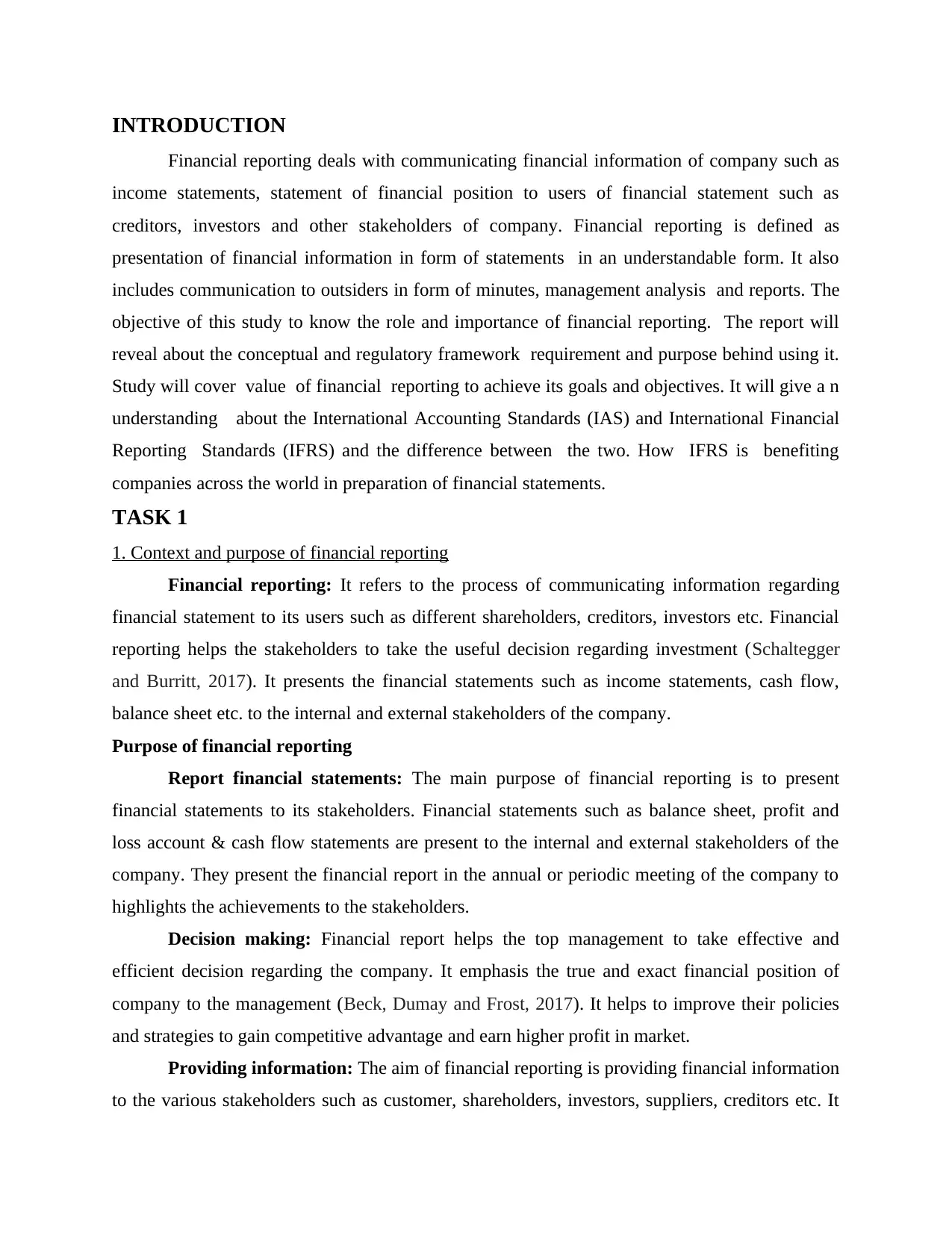
INTRODUCTION
Financial reporting deals with communicating financial information of company such as
income statements, statement of financial position to users of financial statement such as
creditors, investors and other stakeholders of company. Financial reporting is defined as
presentation of financial information in form of statements in an understandable form. It also
includes communication to outsiders in form of minutes, management analysis and reports. The
objective of this study to know the role and importance of financial reporting. The report will
reveal about the conceptual and regulatory framework requirement and purpose behind using it.
Study will cover value of financial reporting to achieve its goals and objectives. It will give a n
understanding about the International Accounting Standards (IAS) and International Financial
Reporting Standards (IFRS) and the difference between the two. How IFRS is benefiting
companies across the world in preparation of financial statements.
TASK 1
1. Context and purpose of financial reporting
Financial reporting: It refers to the process of communicating information regarding
financial statement to its users such as different shareholders, creditors, investors etc. Financial
reporting helps the stakeholders to take the useful decision regarding investment (Schaltegger
and Burritt, 2017). It presents the financial statements such as income statements, cash flow,
balance sheet etc. to the internal and external stakeholders of the company.
Purpose of financial reporting
Report financial statements: The main purpose of financial reporting is to present
financial statements to its stakeholders. Financial statements such as balance sheet, profit and
loss account & cash flow statements are present to the internal and external stakeholders of the
company. They present the financial report in the annual or periodic meeting of the company to
highlights the achievements to the stakeholders.
Decision making: Financial report helps the top management to take effective and
efficient decision regarding the company. It emphasis the true and exact financial position of
company to the management (Beck, Dumay and Frost, 2017). It helps to improve their policies
and strategies to gain competitive advantage and earn higher profit in market.
Providing information: The aim of financial reporting is providing financial information
to the various stakeholders such as customer, shareholders, investors, suppliers, creditors etc. It
Financial reporting deals with communicating financial information of company such as
income statements, statement of financial position to users of financial statement such as
creditors, investors and other stakeholders of company. Financial reporting is defined as
presentation of financial information in form of statements in an understandable form. It also
includes communication to outsiders in form of minutes, management analysis and reports. The
objective of this study to know the role and importance of financial reporting. The report will
reveal about the conceptual and regulatory framework requirement and purpose behind using it.
Study will cover value of financial reporting to achieve its goals and objectives. It will give a n
understanding about the International Accounting Standards (IAS) and International Financial
Reporting Standards (IFRS) and the difference between the two. How IFRS is benefiting
companies across the world in preparation of financial statements.
TASK 1
1. Context and purpose of financial reporting
Financial reporting: It refers to the process of communicating information regarding
financial statement to its users such as different shareholders, creditors, investors etc. Financial
reporting helps the stakeholders to take the useful decision regarding investment (Schaltegger
and Burritt, 2017). It presents the financial statements such as income statements, cash flow,
balance sheet etc. to the internal and external stakeholders of the company.
Purpose of financial reporting
Report financial statements: The main purpose of financial reporting is to present
financial statements to its stakeholders. Financial statements such as balance sheet, profit and
loss account & cash flow statements are present to the internal and external stakeholders of the
company. They present the financial report in the annual or periodic meeting of the company to
highlights the achievements to the stakeholders.
Decision making: Financial report helps the top management to take effective and
efficient decision regarding the company. It emphasis the true and exact financial position of
company to the management (Beck, Dumay and Frost, 2017). It helps to improve their policies
and strategies to gain competitive advantage and earn higher profit in market.
Providing information: The aim of financial reporting is providing financial information
to the various stakeholders such as customer, shareholders, investors, suppliers, creditors etc. It
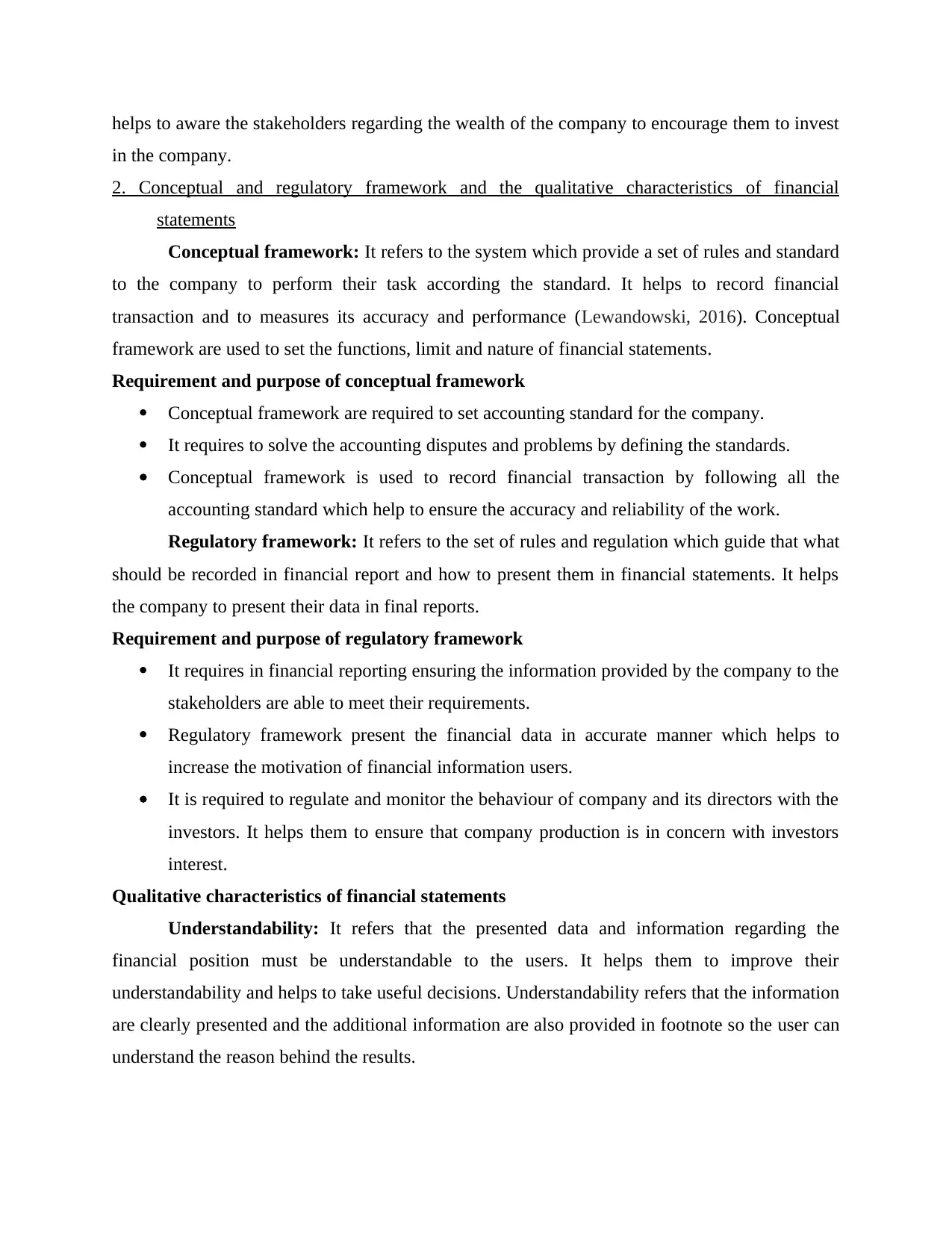
helps to aware the stakeholders regarding the wealth of the company to encourage them to invest
in the company.
2. Conceptual and regulatory framework and the qualitative characteristics of financial
statements
Conceptual framework: It refers to the system which provide a set of rules and standard
to the company to perform their task according the standard. It helps to record financial
transaction and to measures its accuracy and performance (Lewandowski, 2016). Conceptual
framework are used to set the functions, limit and nature of financial statements.
Requirement and purpose of conceptual framework
Conceptual framework are required to set accounting standard for the company.
It requires to solve the accounting disputes and problems by defining the standards.
Conceptual framework is used to record financial transaction by following all the
accounting standard which help to ensure the accuracy and reliability of the work.
Regulatory framework: It refers to the set of rules and regulation which guide that what
should be recorded in financial report and how to present them in financial statements. It helps
the company to present their data in final reports.
Requirement and purpose of regulatory framework
It requires in financial reporting ensuring the information provided by the company to the
stakeholders are able to meet their requirements.
Regulatory framework present the financial data in accurate manner which helps to
increase the motivation of financial information users.
It is required to regulate and monitor the behaviour of company and its directors with the
investors. It helps them to ensure that company production is in concern with investors
interest.
Qualitative characteristics of financial statements
Understandability: It refers that the presented data and information regarding the
financial position must be understandable to the users. It helps them to improve their
understandability and helps to take useful decisions. Understandability refers that the information
are clearly presented and the additional information are also provided in footnote so the user can
understand the reason behind the results.
in the company.
2. Conceptual and regulatory framework and the qualitative characteristics of financial
statements
Conceptual framework: It refers to the system which provide a set of rules and standard
to the company to perform their task according the standard. It helps to record financial
transaction and to measures its accuracy and performance (Lewandowski, 2016). Conceptual
framework are used to set the functions, limit and nature of financial statements.
Requirement and purpose of conceptual framework
Conceptual framework are required to set accounting standard for the company.
It requires to solve the accounting disputes and problems by defining the standards.
Conceptual framework is used to record financial transaction by following all the
accounting standard which help to ensure the accuracy and reliability of the work.
Regulatory framework: It refers to the set of rules and regulation which guide that what
should be recorded in financial report and how to present them in financial statements. It helps
the company to present their data in final reports.
Requirement and purpose of regulatory framework
It requires in financial reporting ensuring the information provided by the company to the
stakeholders are able to meet their requirements.
Regulatory framework present the financial data in accurate manner which helps to
increase the motivation of financial information users.
It is required to regulate and monitor the behaviour of company and its directors with the
investors. It helps them to ensure that company production is in concern with investors
interest.
Qualitative characteristics of financial statements
Understandability: It refers that the presented data and information regarding the
financial position must be understandable to the users. It helps them to improve their
understandability and helps to take useful decisions. Understandability refers that the information
are clearly presented and the additional information are also provided in footnote so the user can
understand the reason behind the results.
Secure Best Marks with AI Grader
Need help grading? Try our AI Grader for instant feedback on your assignments.
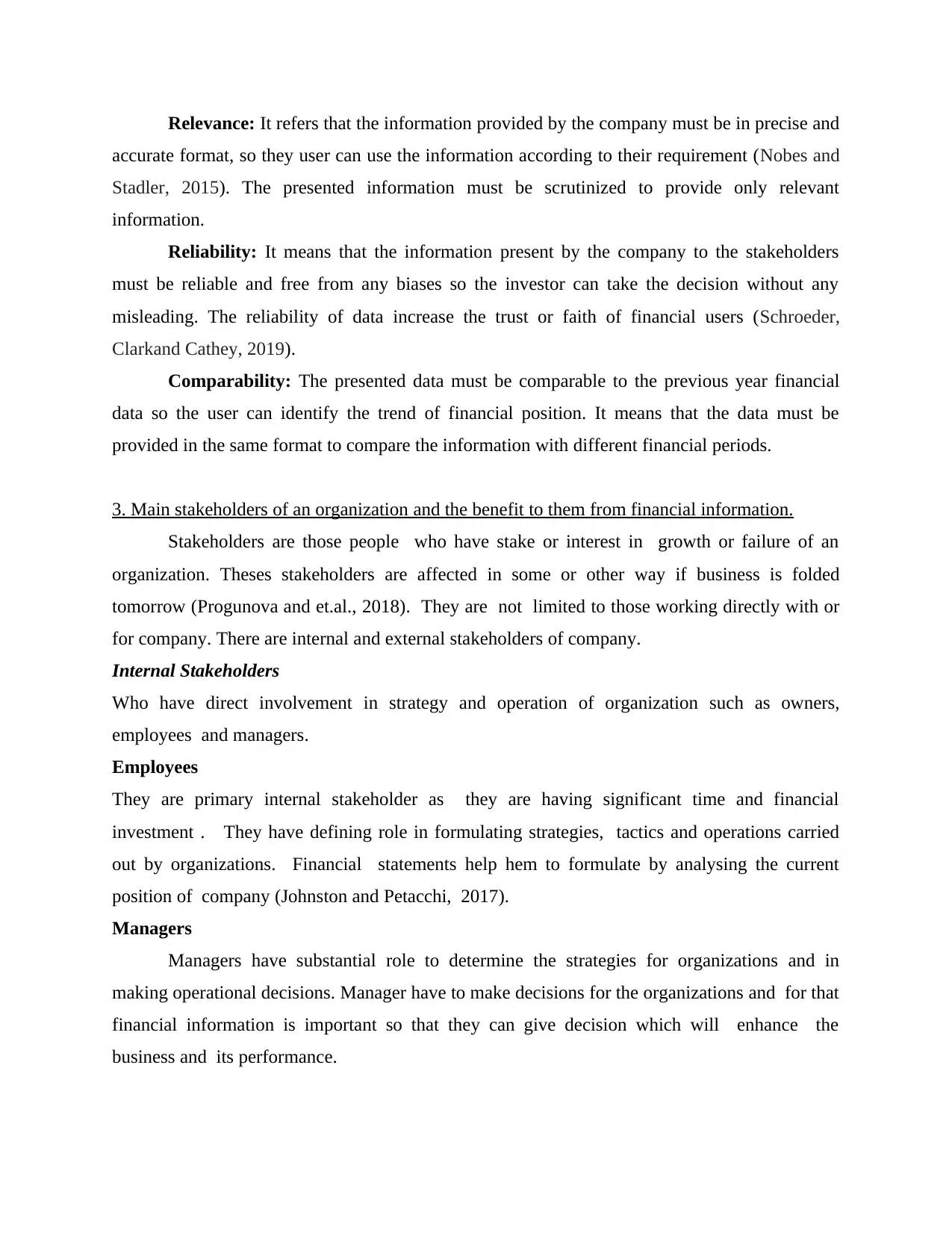
Relevance: It refers that the information provided by the company must be in precise and
accurate format, so they user can use the information according to their requirement (Nobes and
Stadler, 2015). The presented information must be scrutinized to provide only relevant
information.
Reliability: It means that the information present by the company to the stakeholders
must be reliable and free from any biases so the investor can take the decision without any
misleading. The reliability of data increase the trust or faith of financial users (Schroeder,
Clarkand Cathey, 2019).
Comparability: The presented data must be comparable to the previous year financial
data so the user can identify the trend of financial position. It means that the data must be
provided in the same format to compare the information with different financial periods.
3. Main stakeholders of an organization and the benefit to them from financial information.
Stakeholders are those people who have stake or interest in growth or failure of an
organization. Theses stakeholders are affected in some or other way if business is folded
tomorrow (Progunova and et.al., 2018). They are not limited to those working directly with or
for company. There are internal and external stakeholders of company.
Internal Stakeholders
Who have direct involvement in strategy and operation of organization such as owners,
employees and managers.
Employees
They are primary internal stakeholder as they are having significant time and financial
investment . They have defining role in formulating strategies, tactics and operations carried
out by organizations. Financial statements help hem to formulate by analysing the current
position of company (Johnston and Petacchi, 2017).
Managers
Managers have substantial role to determine the strategies for organizations and in
making operational decisions. Manager have to make decisions for the organizations and for that
financial information is important so that they can give decision which will enhance the
business and its performance.
accurate format, so they user can use the information according to their requirement (Nobes and
Stadler, 2015). The presented information must be scrutinized to provide only relevant
information.
Reliability: It means that the information present by the company to the stakeholders
must be reliable and free from any biases so the investor can take the decision without any
misleading. The reliability of data increase the trust or faith of financial users (Schroeder,
Clarkand Cathey, 2019).
Comparability: The presented data must be comparable to the previous year financial
data so the user can identify the trend of financial position. It means that the data must be
provided in the same format to compare the information with different financial periods.
3. Main stakeholders of an organization and the benefit to them from financial information.
Stakeholders are those people who have stake or interest in growth or failure of an
organization. Theses stakeholders are affected in some or other way if business is folded
tomorrow (Progunova and et.al., 2018). They are not limited to those working directly with or
for company. There are internal and external stakeholders of company.
Internal Stakeholders
Who have direct involvement in strategy and operation of organization such as owners,
employees and managers.
Employees
They are primary internal stakeholder as they are having significant time and financial
investment . They have defining role in formulating strategies, tactics and operations carried
out by organizations. Financial statements help hem to formulate by analysing the current
position of company (Johnston and Petacchi, 2017).
Managers
Managers have substantial role to determine the strategies for organizations and in
making operational decisions. Manager have to make decisions for the organizations and for that
financial information is important so that they can give decision which will enhance the
business and its performance.
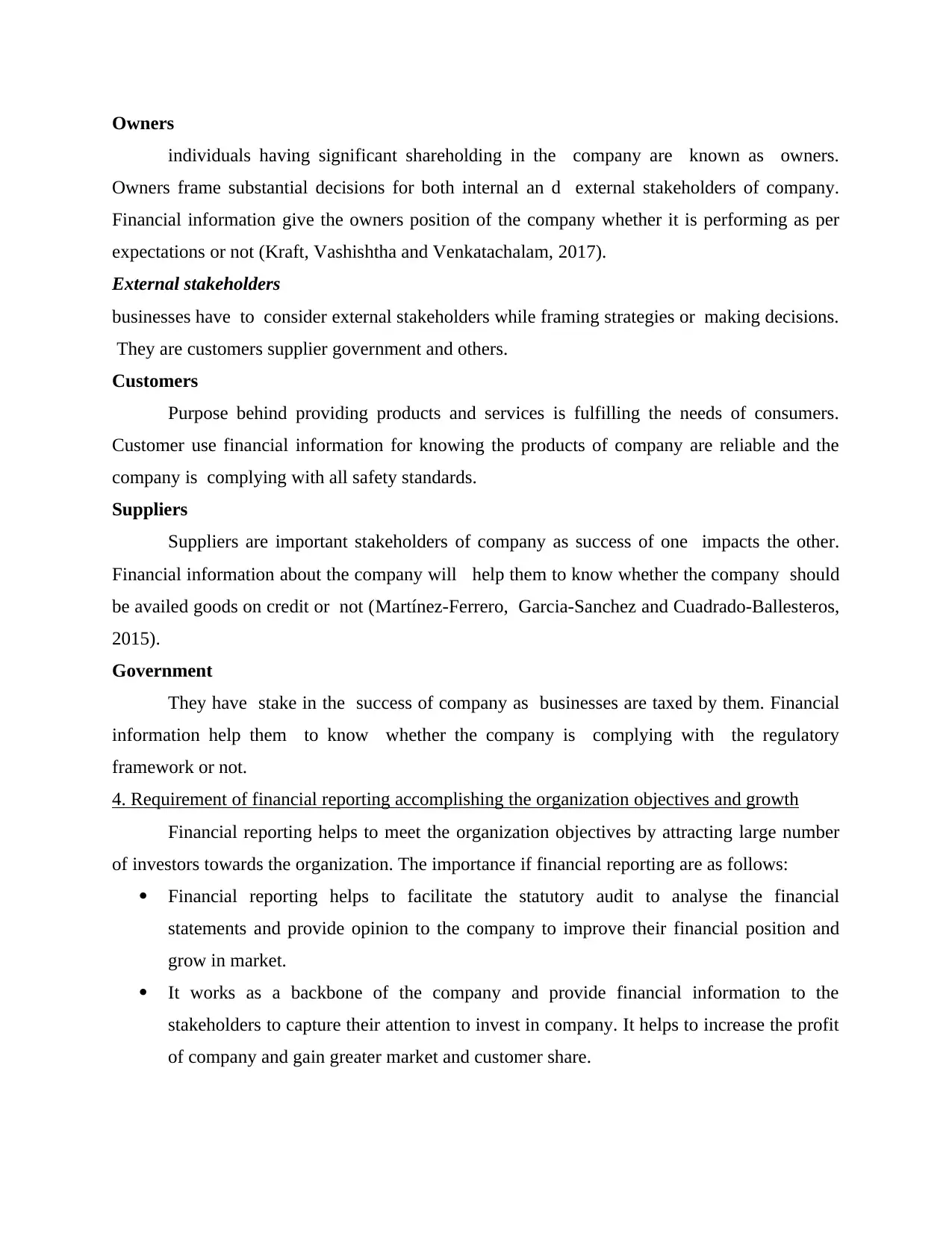
Owners
individuals having significant shareholding in the company are known as owners.
Owners frame substantial decisions for both internal an d external stakeholders of company.
Financial information give the owners position of the company whether it is performing as per
expectations or not (Kraft, Vashishtha and Venkatachalam, 2017).
External stakeholders
businesses have to consider external stakeholders while framing strategies or making decisions.
They are customers supplier government and others.
Customers
Purpose behind providing products and services is fulfilling the needs of consumers.
Customer use financial information for knowing the products of company are reliable and the
company is complying with all safety standards.
Suppliers
Suppliers are important stakeholders of company as success of one impacts the other.
Financial information about the company will help them to know whether the company should
be availed goods on credit or not (Martínez‐Ferrero, Garcia‐Sanchez and Cuadrado‐Ballesteros,
2015).
Government
They have stake in the success of company as businesses are taxed by them. Financial
information help them to know whether the company is complying with the regulatory
framework or not.
4. Requirement of financial reporting accomplishing the organization objectives and growth
Financial reporting helps to meet the organization objectives by attracting large number
of investors towards the organization. The importance if financial reporting are as follows:
Financial reporting helps to facilitate the statutory audit to analyse the financial
statements and provide opinion to the company to improve their financial position and
grow in market.
It works as a backbone of the company and provide financial information to the
stakeholders to capture their attention to invest in company. It helps to increase the profit
of company and gain greater market and customer share.
individuals having significant shareholding in the company are known as owners.
Owners frame substantial decisions for both internal an d external stakeholders of company.
Financial information give the owners position of the company whether it is performing as per
expectations or not (Kraft, Vashishtha and Venkatachalam, 2017).
External stakeholders
businesses have to consider external stakeholders while framing strategies or making decisions.
They are customers supplier government and others.
Customers
Purpose behind providing products and services is fulfilling the needs of consumers.
Customer use financial information for knowing the products of company are reliable and the
company is complying with all safety standards.
Suppliers
Suppliers are important stakeholders of company as success of one impacts the other.
Financial information about the company will help them to know whether the company should
be availed goods on credit or not (Martínez‐Ferrero, Garcia‐Sanchez and Cuadrado‐Ballesteros,
2015).
Government
They have stake in the success of company as businesses are taxed by them. Financial
information help them to know whether the company is complying with the regulatory
framework or not.
4. Requirement of financial reporting accomplishing the organization objectives and growth
Financial reporting helps to meet the organization objectives by attracting large number
of investors towards the organization. The importance if financial reporting are as follows:
Financial reporting helps to facilitate the statutory audit to analyse the financial
statements and provide opinion to the company to improve their financial position and
grow in market.
It works as a backbone of the company and provide financial information to the
stakeholders to capture their attention to invest in company. It helps to increase the profit
of company and gain greater market and customer share.
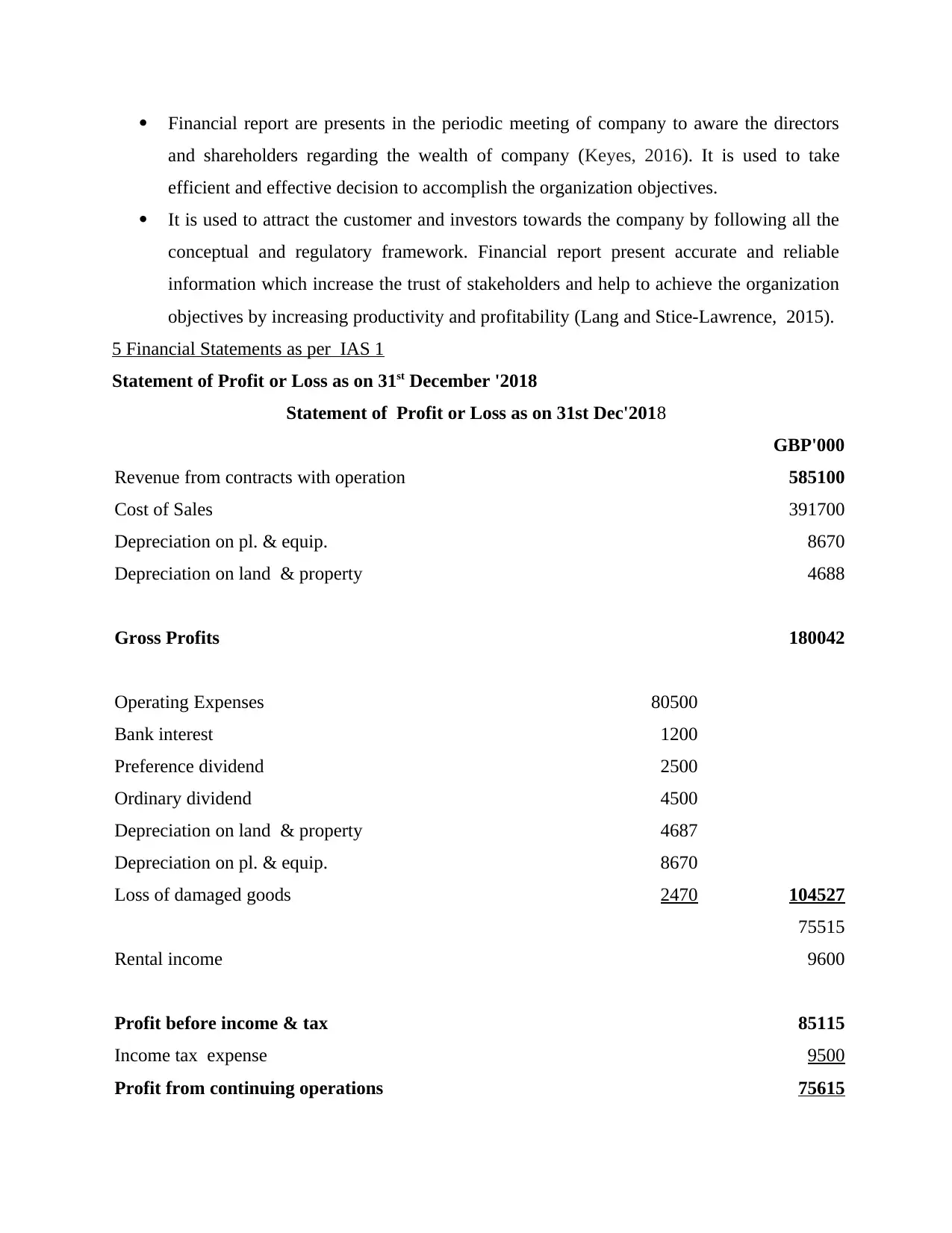
Financial report are presents in the periodic meeting of company to aware the directors
and shareholders regarding the wealth of company (Keyes, 2016). It is used to take
efficient and effective decision to accomplish the organization objectives.
It is used to attract the customer and investors towards the company by following all the
conceptual and regulatory framework. Financial report present accurate and reliable
information which increase the trust of stakeholders and help to achieve the organization
objectives by increasing productivity and profitability (Lang and Stice-Lawrence, 2015).
5 Financial Statements as per IAS 1
Statement of Profit or Loss as on 31st December '2018
Statement of Profit or Loss as on 31st Dec'2018
GBP'000
Revenue from contracts with operation 585100
Cost of Sales 391700
Depreciation on pl. & equip. 8670
Depreciation on land & property 4688
Gross Profits 180042
Operating Expenses 80500
Bank interest 1200
Preference dividend 2500
Ordinary dividend 4500
Depreciation on land & property 4687
Depreciation on pl. & equip. 8670
Loss of damaged goods 2470 104527
75515
Rental income 9600
Profit before income & tax 85115
Income tax expense 9500
Profit from continuing operations 75615
and shareholders regarding the wealth of company (Keyes, 2016). It is used to take
efficient and effective decision to accomplish the organization objectives.
It is used to attract the customer and investors towards the company by following all the
conceptual and regulatory framework. Financial report present accurate and reliable
information which increase the trust of stakeholders and help to achieve the organization
objectives by increasing productivity and profitability (Lang and Stice-Lawrence, 2015).
5 Financial Statements as per IAS 1
Statement of Profit or Loss as on 31st December '2018
Statement of Profit or Loss as on 31st Dec'2018
GBP'000
Revenue from contracts with operation 585100
Cost of Sales 391700
Depreciation on pl. & equip. 8670
Depreciation on land & property 4688
Gross Profits 180042
Operating Expenses 80500
Bank interest 1200
Preference dividend 2500
Ordinary dividend 4500
Depreciation on land & property 4687
Depreciation on pl. & equip. 8670
Loss of damaged goods 2470 104527
75515
Rental income 9600
Profit before income & tax 85115
Income tax expense 9500
Profit from continuing operations 75615
Paraphrase This Document
Need a fresh take? Get an instant paraphrase of this document with our AI Paraphraser
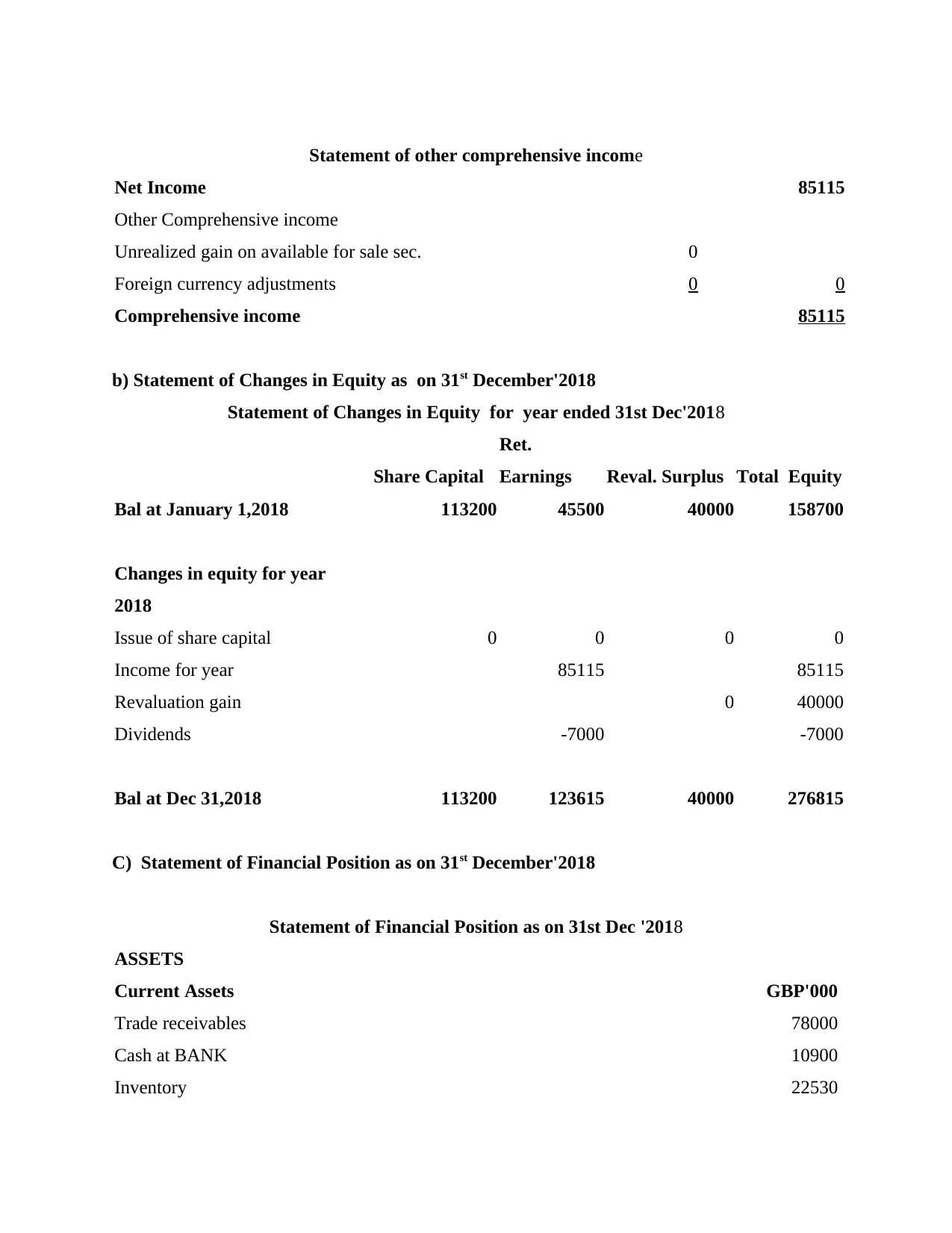
Statement of other comprehensive income
Net Income 85115
Other Comprehensive income
Unrealized gain on available for sale sec. 0
Foreign currency adjustments 0 0
Comprehensive income 85115
b) Statement of Changes in Equity as on 31st December'2018
Statement of Changes in Equity for year ended 31st Dec'2018
Share Capital
Ret.
Earnings Reval. Surplus Total Equity
Bal at January 1,2018 113200 45500 40000 158700
Changes in equity for year
2018
Issue of share capital 0 0 0 0
Income for year 85115 85115
Revaluation gain 0 40000
Dividends -7000 -7000
Bal at Dec 31,2018 113200 123615 40000 276815
C) Statement of Financial Position as on 31st December'2018
Statement of Financial Position as on 31st Dec '2018
ASSETS
Current Assets GBP'000
Trade receivables 78000
Cash at BANK 10900
Inventory 22530
Net Income 85115
Other Comprehensive income
Unrealized gain on available for sale sec. 0
Foreign currency adjustments 0 0
Comprehensive income 85115
b) Statement of Changes in Equity as on 31st December'2018
Statement of Changes in Equity for year ended 31st Dec'2018
Share Capital
Ret.
Earnings Reval. Surplus Total Equity
Bal at January 1,2018 113200 45500 40000 158700
Changes in equity for year
2018
Issue of share capital 0 0 0 0
Income for year 85115 85115
Revaluation gain 0 40000
Dividends -7000 -7000
Bal at Dec 31,2018 113200 123615 40000 276815
C) Statement of Financial Position as on 31st December'2018
Statement of Financial Position as on 31st Dec '2018
ASSETS
Current Assets GBP'000
Trade receivables 78000
Cash at BANK 10900
Inventory 22530
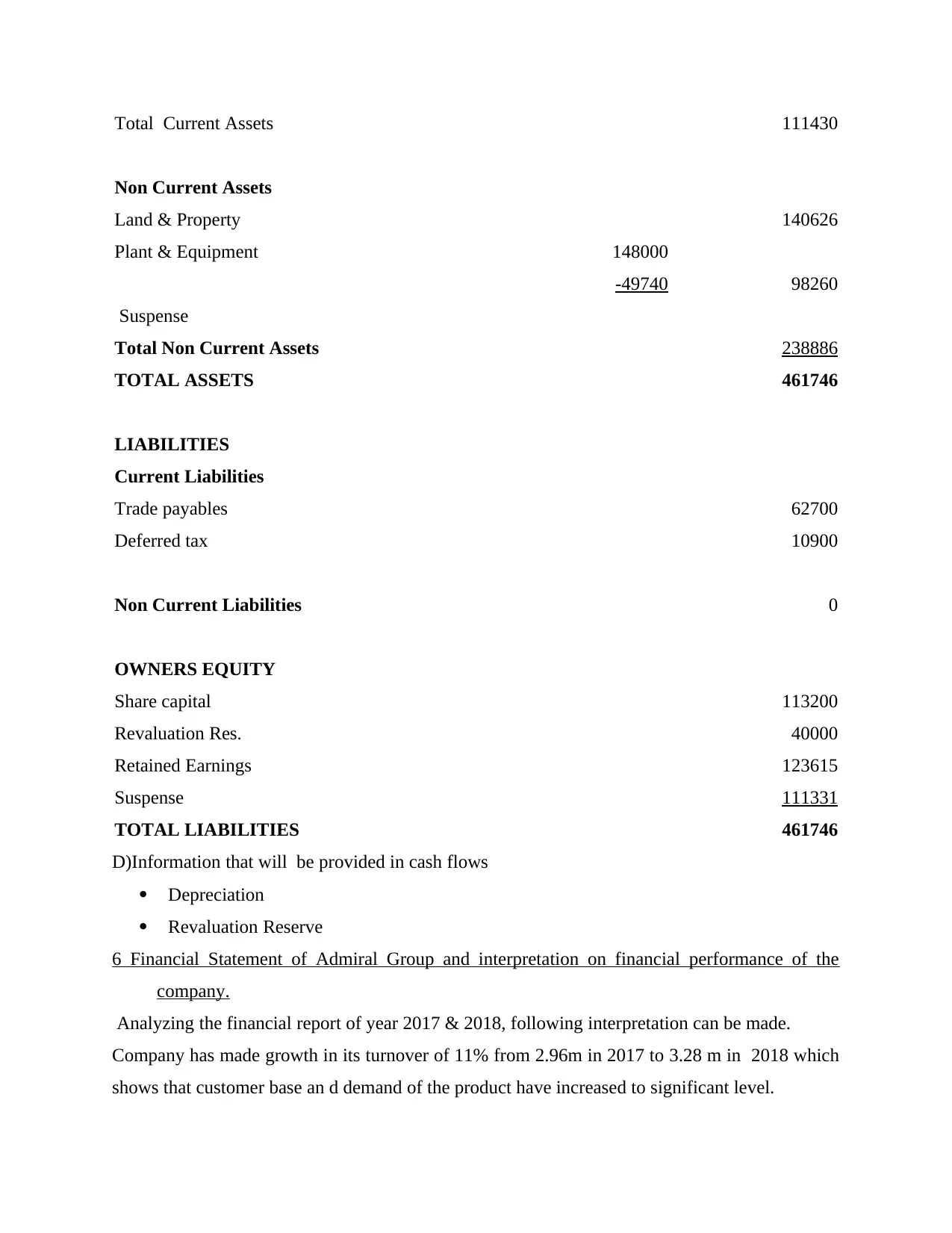
Total Current Assets 111430
Non Current Assets
Land & Property 140626
Plant & Equipment 148000
-49740 98260
Suspense
Total Non Current Assets 238886
TOTAL ASSETS 461746
LIABILITIES
Current Liabilities
Trade payables 62700
Deferred tax 10900
Non Current Liabilities 0
OWNERS EQUITY
Share capital 113200
Revaluation Res. 40000
Retained Earnings 123615
Suspense 111331
TOTAL LIABILITIES 461746
D)Information that will be provided in cash flows
Depreciation
Revaluation Reserve
6 Financial Statement of Admiral Group and interpretation on financial performance of the
company.
Analyzing the financial report of year 2017 & 2018, following interpretation can be made.
Company has made growth in its turnover of 11% from 2.96m in 2017 to 3.28 m in 2018 which
shows that customer base an d demand of the product have increased to significant level.
Non Current Assets
Land & Property 140626
Plant & Equipment 148000
-49740 98260
Suspense
Total Non Current Assets 238886
TOTAL ASSETS 461746
LIABILITIES
Current Liabilities
Trade payables 62700
Deferred tax 10900
Non Current Liabilities 0
OWNERS EQUITY
Share capital 113200
Revaluation Res. 40000
Retained Earnings 123615
Suspense 111331
TOTAL LIABILITIES 461746
D)Information that will be provided in cash flows
Depreciation
Revaluation Reserve
6 Financial Statement of Admiral Group and interpretation on financial performance of the
company.
Analyzing the financial report of year 2017 & 2018, following interpretation can be made.
Company has made growth in its turnover of 11% from 2.96m in 2017 to 3.28 m in 2018 which
shows that customer base an d demand of the product have increased to significant level.
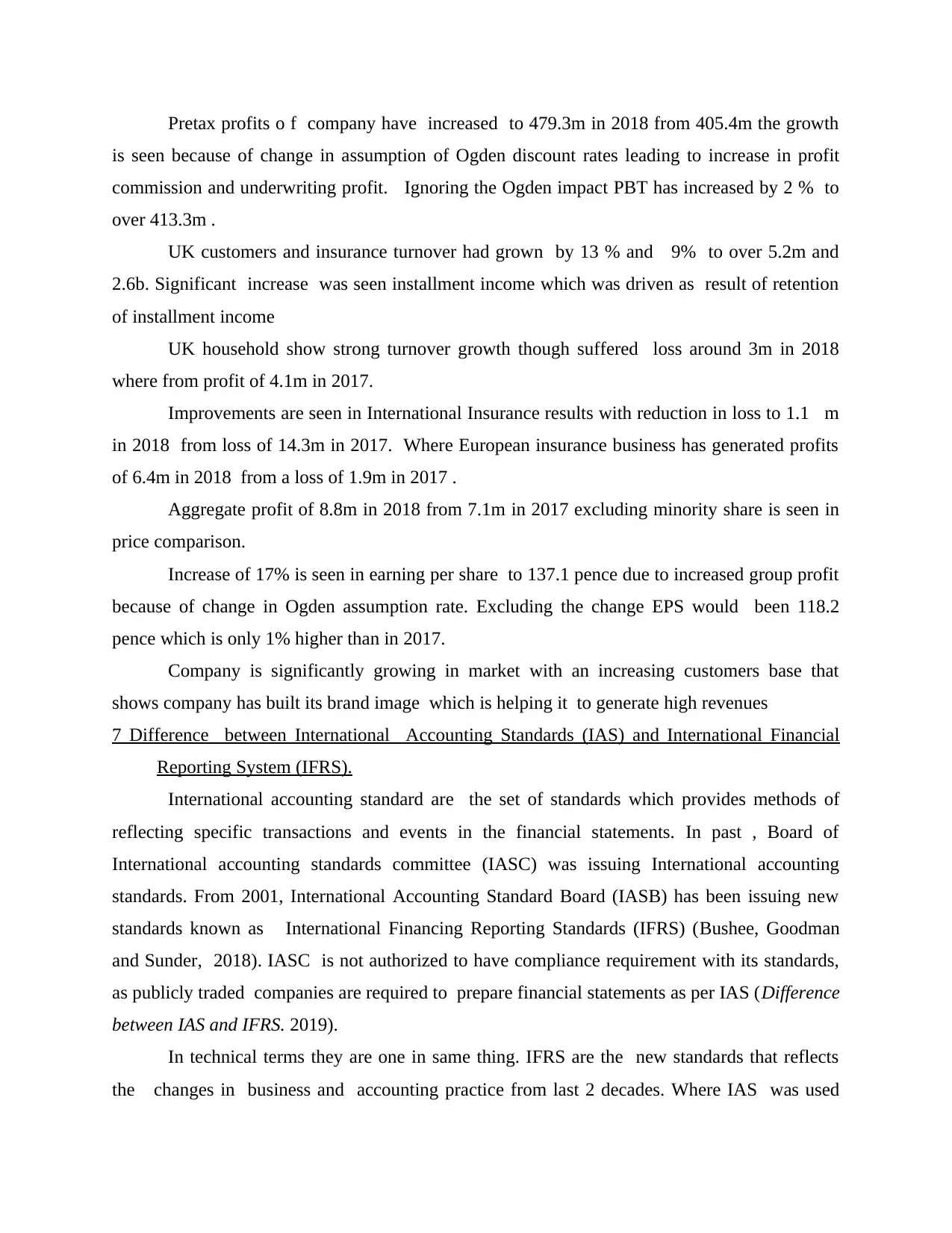
Pretax profits o f company have increased to 479.3m in 2018 from 405.4m the growth
is seen because of change in assumption of Ogden discount rates leading to increase in profit
commission and underwriting profit. Ignoring the Ogden impact PBT has increased by 2 % to
over 413.3m .
UK customers and insurance turnover had grown by 13 % and 9% to over 5.2m and
2.6b. Significant increase was seen installment income which was driven as result of retention
of installment income
UK household show strong turnover growth though suffered loss around 3m in 2018
where from profit of 4.1m in 2017.
Improvements are seen in International Insurance results with reduction in loss to 1.1 m
in 2018 from loss of 14.3m in 2017. Where European insurance business has generated profits
of 6.4m in 2018 from a loss of 1.9m in 2017 .
Aggregate profit of 8.8m in 2018 from 7.1m in 2017 excluding minority share is seen in
price comparison.
Increase of 17% is seen in earning per share to 137.1 pence due to increased group profit
because of change in Ogden assumption rate. Excluding the change EPS would been 118.2
pence which is only 1% higher than in 2017.
Company is significantly growing in market with an increasing customers base that
shows company has built its brand image which is helping it to generate high revenues
7 Difference between International Accounting Standards (IAS) and International Financial
Reporting System (IFRS).
International accounting standard are the set of standards which provides methods of
reflecting specific transactions and events in the financial statements. In past , Board of
International accounting standards committee (IASC) was issuing International accounting
standards. From 2001, International Accounting Standard Board (IASB) has been issuing new
standards known as International Financing Reporting Standards (IFRS) (Bushee, Goodman
and Sunder, 2018). IASC is not authorized to have compliance requirement with its standards,
as publicly traded companies are required to prepare financial statements as per IAS (Difference
between IAS and IFRS. 2019).
In technical terms they are one in same thing. IFRS are the new standards that reflects
the changes in business and accounting practice from last 2 decades. Where IAS was used
is seen because of change in assumption of Ogden discount rates leading to increase in profit
commission and underwriting profit. Ignoring the Ogden impact PBT has increased by 2 % to
over 413.3m .
UK customers and insurance turnover had grown by 13 % and 9% to over 5.2m and
2.6b. Significant increase was seen installment income which was driven as result of retention
of installment income
UK household show strong turnover growth though suffered loss around 3m in 2018
where from profit of 4.1m in 2017.
Improvements are seen in International Insurance results with reduction in loss to 1.1 m
in 2018 from loss of 14.3m in 2017. Where European insurance business has generated profits
of 6.4m in 2018 from a loss of 1.9m in 2017 .
Aggregate profit of 8.8m in 2018 from 7.1m in 2017 excluding minority share is seen in
price comparison.
Increase of 17% is seen in earning per share to 137.1 pence due to increased group profit
because of change in Ogden assumption rate. Excluding the change EPS would been 118.2
pence which is only 1% higher than in 2017.
Company is significantly growing in market with an increasing customers base that
shows company has built its brand image which is helping it to generate high revenues
7 Difference between International Accounting Standards (IAS) and International Financial
Reporting System (IFRS).
International accounting standard are the set of standards which provides methods of
reflecting specific transactions and events in the financial statements. In past , Board of
International accounting standards committee (IASC) was issuing International accounting
standards. From 2001, International Accounting Standard Board (IASB) has been issuing new
standards known as International Financing Reporting Standards (IFRS) (Bushee, Goodman
and Sunder, 2018). IASC is not authorized to have compliance requirement with its standards,
as publicly traded companies are required to prepare financial statements as per IAS (Difference
between IAS and IFRS. 2019).
In technical terms they are one in same thing. IFRS are the new standards that reflects
the changes in business and accounting practice from last 2 decades. Where IAS was used
Secure Best Marks with AI Grader
Need help grading? Try our AI Grader for instant feedback on your assignments.
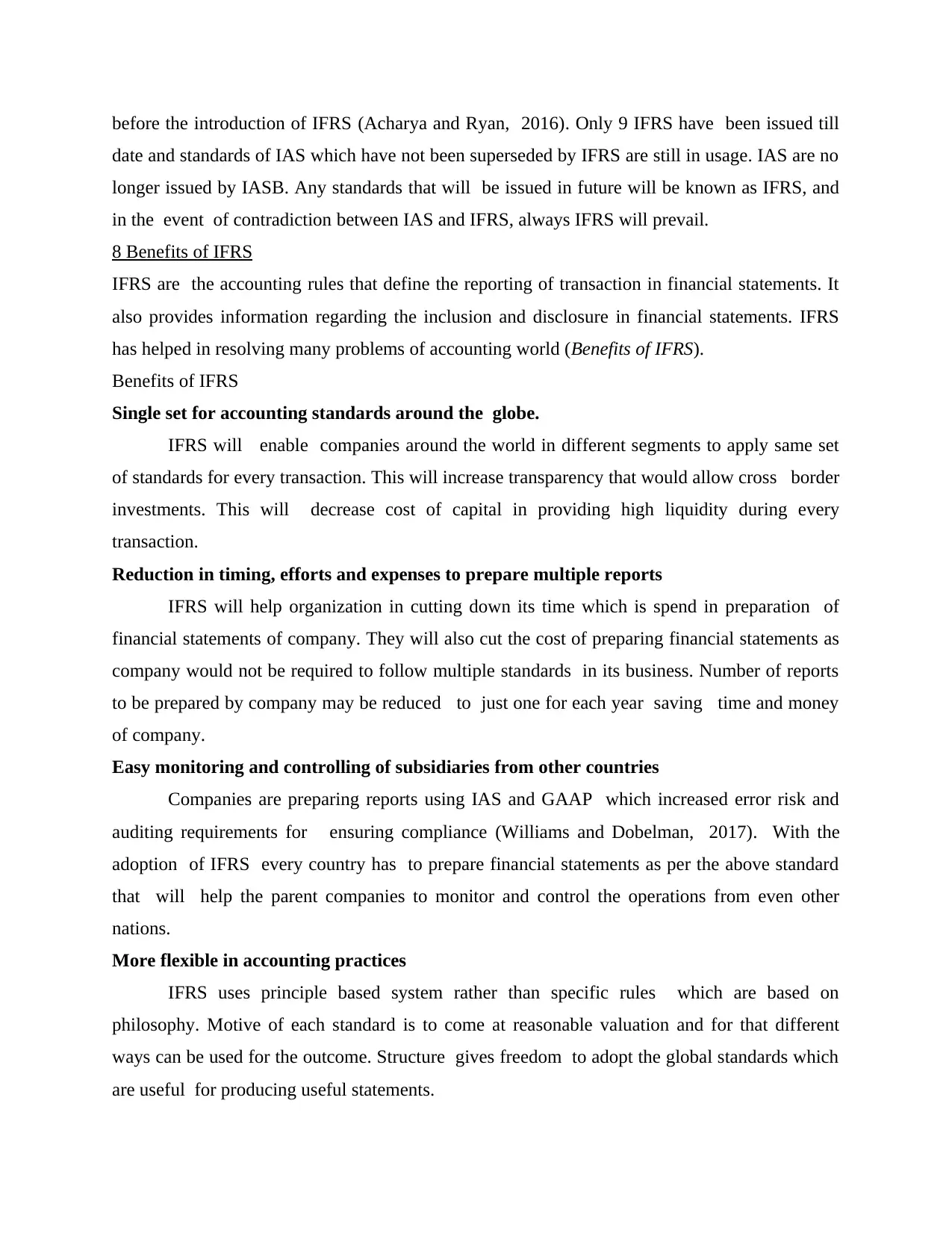
before the introduction of IFRS (Acharya and Ryan, 2016). Only 9 IFRS have been issued till
date and standards of IAS which have not been superseded by IFRS are still in usage. IAS are no
longer issued by IASB. Any standards that will be issued in future will be known as IFRS, and
in the event of contradiction between IAS and IFRS, always IFRS will prevail.
8 Benefits of IFRS
IFRS are the accounting rules that define the reporting of transaction in financial statements. It
also provides information regarding the inclusion and disclosure in financial statements. IFRS
has helped in resolving many problems of accounting world (Benefits of IFRS).
Benefits of IFRS
Single set for accounting standards around the globe.
IFRS will enable companies around the world in different segments to apply same set
of standards for every transaction. This will increase transparency that would allow cross border
investments. This will decrease cost of capital in providing high liquidity during every
transaction.
Reduction in timing, efforts and expenses to prepare multiple reports
IFRS will help organization in cutting down its time which is spend in preparation of
financial statements of company. They will also cut the cost of preparing financial statements as
company would not be required to follow multiple standards in its business. Number of reports
to be prepared by company may be reduced to just one for each year saving time and money
of company.
Easy monitoring and controlling of subsidiaries from other countries
Companies are preparing reports using IAS and GAAP which increased error risk and
auditing requirements for ensuring compliance (Williams and Dobelman, 2017). With the
adoption of IFRS every country has to prepare financial statements as per the above standard
that will help the parent companies to monitor and control the operations from even other
nations.
More flexible in accounting practices
IFRS uses principle based system rather than specific rules which are based on
philosophy. Motive of each standard is to come at reasonable valuation and for that different
ways can be used for the outcome. Structure gives freedom to adopt the global standards which
are useful for producing useful statements.
date and standards of IAS which have not been superseded by IFRS are still in usage. IAS are no
longer issued by IASB. Any standards that will be issued in future will be known as IFRS, and
in the event of contradiction between IAS and IFRS, always IFRS will prevail.
8 Benefits of IFRS
IFRS are the accounting rules that define the reporting of transaction in financial statements. It
also provides information regarding the inclusion and disclosure in financial statements. IFRS
has helped in resolving many problems of accounting world (Benefits of IFRS).
Benefits of IFRS
Single set for accounting standards around the globe.
IFRS will enable companies around the world in different segments to apply same set
of standards for every transaction. This will increase transparency that would allow cross border
investments. This will decrease cost of capital in providing high liquidity during every
transaction.
Reduction in timing, efforts and expenses to prepare multiple reports
IFRS will help organization in cutting down its time which is spend in preparation of
financial statements of company. They will also cut the cost of preparing financial statements as
company would not be required to follow multiple standards in its business. Number of reports
to be prepared by company may be reduced to just one for each year saving time and money
of company.
Easy monitoring and controlling of subsidiaries from other countries
Companies are preparing reports using IAS and GAAP which increased error risk and
auditing requirements for ensuring compliance (Williams and Dobelman, 2017). With the
adoption of IFRS every country has to prepare financial statements as per the above standard
that will help the parent companies to monitor and control the operations from even other
nations.
More flexible in accounting practices
IFRS uses principle based system rather than specific rules which are based on
philosophy. Motive of each standard is to come at reasonable valuation and for that different
ways can be used for the outcome. Structure gives freedom to adopt the global standards which
are useful for producing useful statements.
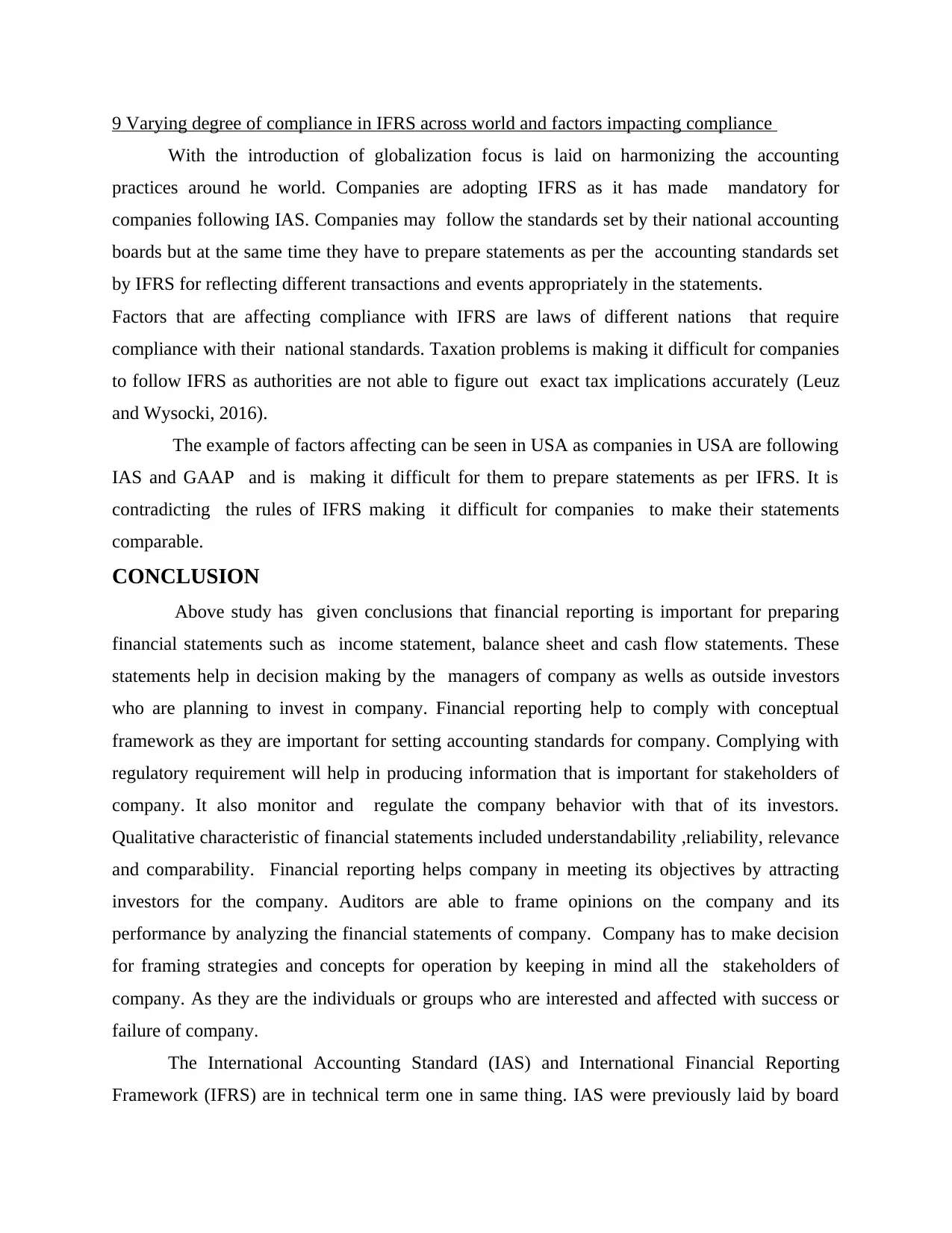
9 Varying degree of compliance in IFRS across world and factors impacting compliance
With the introduction of globalization focus is laid on harmonizing the accounting
practices around he world. Companies are adopting IFRS as it has made mandatory for
companies following IAS. Companies may follow the standards set by their national accounting
boards but at the same time they have to prepare statements as per the accounting standards set
by IFRS for reflecting different transactions and events appropriately in the statements.
Factors that are affecting compliance with IFRS are laws of different nations that require
compliance with their national standards. Taxation problems is making it difficult for companies
to follow IFRS as authorities are not able to figure out exact tax implications accurately (Leuz
and Wysocki, 2016).
The example of factors affecting can be seen in USA as companies in USA are following
IAS and GAAP and is making it difficult for them to prepare statements as per IFRS. It is
contradicting the rules of IFRS making it difficult for companies to make their statements
comparable.
CONCLUSION
Above study has given conclusions that financial reporting is important for preparing
financial statements such as income statement, balance sheet and cash flow statements. These
statements help in decision making by the managers of company as wells as outside investors
who are planning to invest in company. Financial reporting help to comply with conceptual
framework as they are important for setting accounting standards for company. Complying with
regulatory requirement will help in producing information that is important for stakeholders of
company. It also monitor and regulate the company behavior with that of its investors.
Qualitative characteristic of financial statements included understandability ,reliability, relevance
and comparability. Financial reporting helps company in meeting its objectives by attracting
investors for the company. Auditors are able to frame opinions on the company and its
performance by analyzing the financial statements of company. Company has to make decision
for framing strategies and concepts for operation by keeping in mind all the stakeholders of
company. As they are the individuals or groups who are interested and affected with success or
failure of company.
The International Accounting Standard (IAS) and International Financial Reporting
Framework (IFRS) are in technical term one in same thing. IAS were previously laid by board
With the introduction of globalization focus is laid on harmonizing the accounting
practices around he world. Companies are adopting IFRS as it has made mandatory for
companies following IAS. Companies may follow the standards set by their national accounting
boards but at the same time they have to prepare statements as per the accounting standards set
by IFRS for reflecting different transactions and events appropriately in the statements.
Factors that are affecting compliance with IFRS are laws of different nations that require
compliance with their national standards. Taxation problems is making it difficult for companies
to follow IFRS as authorities are not able to figure out exact tax implications accurately (Leuz
and Wysocki, 2016).
The example of factors affecting can be seen in USA as companies in USA are following
IAS and GAAP and is making it difficult for them to prepare statements as per IFRS. It is
contradicting the rules of IFRS making it difficult for companies to make their statements
comparable.
CONCLUSION
Above study has given conclusions that financial reporting is important for preparing
financial statements such as income statement, balance sheet and cash flow statements. These
statements help in decision making by the managers of company as wells as outside investors
who are planning to invest in company. Financial reporting help to comply with conceptual
framework as they are important for setting accounting standards for company. Complying with
regulatory requirement will help in producing information that is important for stakeholders of
company. It also monitor and regulate the company behavior with that of its investors.
Qualitative characteristic of financial statements included understandability ,reliability, relevance
and comparability. Financial reporting helps company in meeting its objectives by attracting
investors for the company. Auditors are able to frame opinions on the company and its
performance by analyzing the financial statements of company. Company has to make decision
for framing strategies and concepts for operation by keeping in mind all the stakeholders of
company. As they are the individuals or groups who are interested and affected with success or
failure of company.
The International Accounting Standard (IAS) and International Financial Reporting
Framework (IFRS) are in technical term one in same thing. IAS were previously laid by board

and from 2001, standards were introduced known as IFRS. It is benefiting companies around
the world as they now have to comply with single accounting framework which is acceptable
in all countries.
the world as they now have to comply with single accounting framework which is acceptable
in all countries.
Paraphrase This Document
Need a fresh take? Get an instant paraphrase of this document with our AI Paraphraser
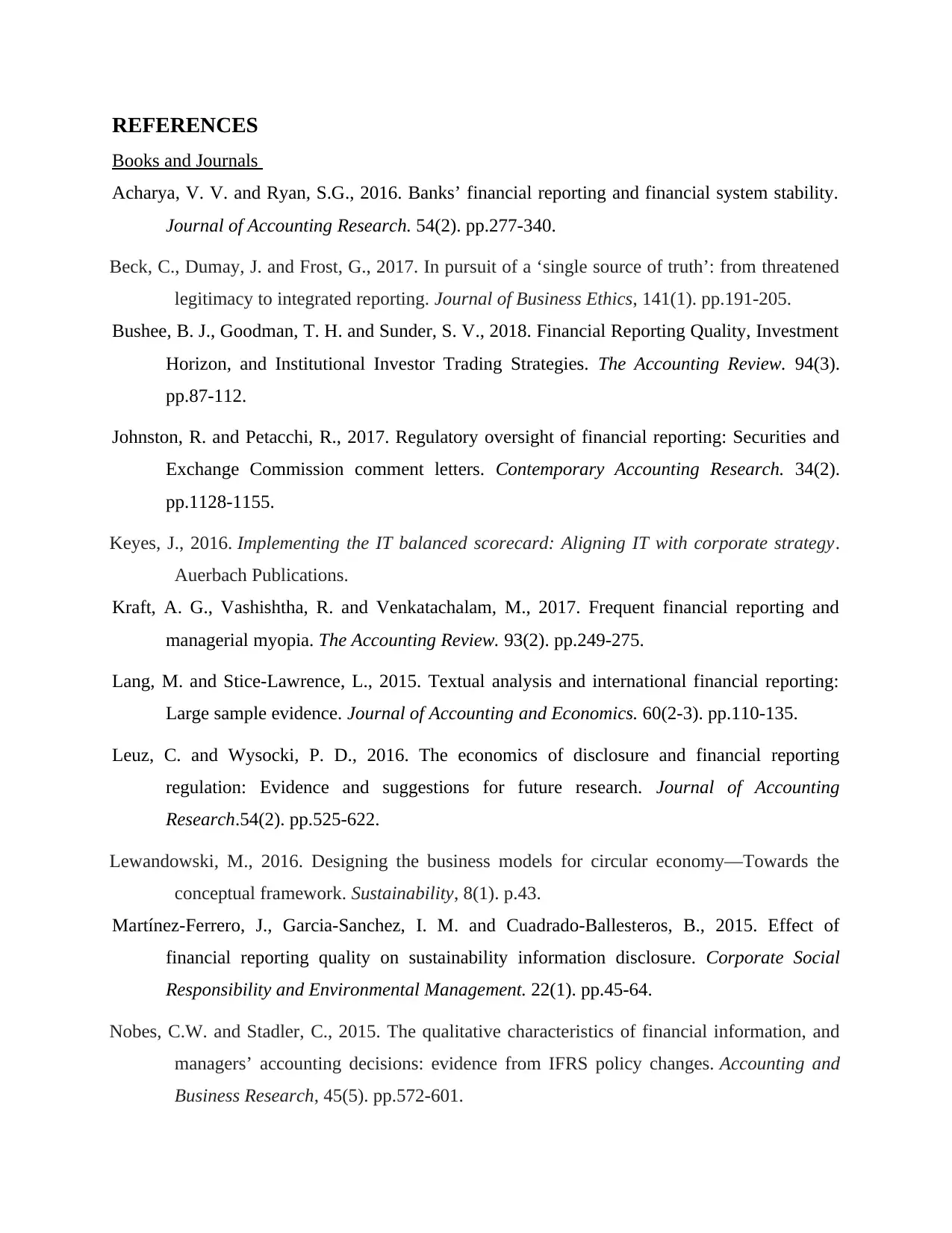
REFERENCES
Books and Journals
Acharya, V. V. and Ryan, S.G., 2016. Banks’ financial reporting and financial system stability.
Journal of Accounting Research. 54(2). pp.277-340.
Beck, C., Dumay, J. and Frost, G., 2017. In pursuit of a ‘single source of truth’: from threatened
legitimacy to integrated reporting. Journal of Business Ethics, 141(1). pp.191-205.
Bushee, B. J., Goodman, T. H. and Sunder, S. V., 2018. Financial Reporting Quality, Investment
Horizon, and Institutional Investor Trading Strategies. The Accounting Review. 94(3).
pp.87-112.
Johnston, R. and Petacchi, R., 2017. Regulatory oversight of financial reporting: Securities and
Exchange Commission comment letters. Contemporary Accounting Research. 34(2).
pp.1128-1155.
Keyes, J., 2016. Implementing the IT balanced scorecard: Aligning IT with corporate strategy.
Auerbach Publications.
Kraft, A. G., Vashishtha, R. and Venkatachalam, M., 2017. Frequent financial reporting and
managerial myopia. The Accounting Review. 93(2). pp.249-275.
Lang, M. and Stice-Lawrence, L., 2015. Textual analysis and international financial reporting:
Large sample evidence. Journal of Accounting and Economics. 60(2-3). pp.110-135.
Leuz, C. and Wysocki, P. D., 2016. The economics of disclosure and financial reporting
regulation: Evidence and suggestions for future research. Journal of Accounting
Research.54(2). pp.525-622.
Lewandowski, M., 2016. Designing the business models for circular economy—Towards the
conceptual framework. Sustainability, 8(1). p.43.
Martínez‐Ferrero, J., Garcia‐Sanchez, I. M. and Cuadrado‐Ballesteros, B., 2015. Effect of
financial reporting quality on sustainability information disclosure. Corporate Social
Responsibility and Environmental Management. 22(1). pp.45-64.
Nobes, C.W. and Stadler, C., 2015. The qualitative characteristics of financial information, and
managers’ accounting decisions: evidence from IFRS policy changes. Accounting and
Business Research, 45(5). pp.572-601.
Books and Journals
Acharya, V. V. and Ryan, S.G., 2016. Banks’ financial reporting and financial system stability.
Journal of Accounting Research. 54(2). pp.277-340.
Beck, C., Dumay, J. and Frost, G., 2017. In pursuit of a ‘single source of truth’: from threatened
legitimacy to integrated reporting. Journal of Business Ethics, 141(1). pp.191-205.
Bushee, B. J., Goodman, T. H. and Sunder, S. V., 2018. Financial Reporting Quality, Investment
Horizon, and Institutional Investor Trading Strategies. The Accounting Review. 94(3).
pp.87-112.
Johnston, R. and Petacchi, R., 2017. Regulatory oversight of financial reporting: Securities and
Exchange Commission comment letters. Contemporary Accounting Research. 34(2).
pp.1128-1155.
Keyes, J., 2016. Implementing the IT balanced scorecard: Aligning IT with corporate strategy.
Auerbach Publications.
Kraft, A. G., Vashishtha, R. and Venkatachalam, M., 2017. Frequent financial reporting and
managerial myopia. The Accounting Review. 93(2). pp.249-275.
Lang, M. and Stice-Lawrence, L., 2015. Textual analysis and international financial reporting:
Large sample evidence. Journal of Accounting and Economics. 60(2-3). pp.110-135.
Leuz, C. and Wysocki, P. D., 2016. The economics of disclosure and financial reporting
regulation: Evidence and suggestions for future research. Journal of Accounting
Research.54(2). pp.525-622.
Lewandowski, M., 2016. Designing the business models for circular economy—Towards the
conceptual framework. Sustainability, 8(1). p.43.
Martínez‐Ferrero, J., Garcia‐Sanchez, I. M. and Cuadrado‐Ballesteros, B., 2015. Effect of
financial reporting quality on sustainability information disclosure. Corporate Social
Responsibility and Environmental Management. 22(1). pp.45-64.
Nobes, C.W. and Stadler, C., 2015. The qualitative characteristics of financial information, and
managers’ accounting decisions: evidence from IFRS policy changes. Accounting and
Business Research, 45(5). pp.572-601.
1 out of 14
Related Documents
Your All-in-One AI-Powered Toolkit for Academic Success.
+13062052269
info@desklib.com
Available 24*7 on WhatsApp / Email
![[object Object]](/_next/static/media/star-bottom.7253800d.svg)
Unlock your academic potential
© 2024 | Zucol Services PVT LTD | All rights reserved.





